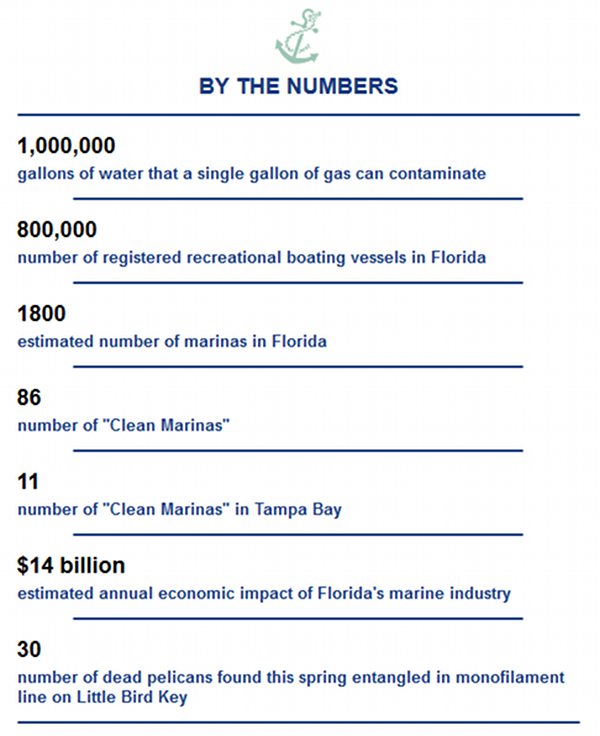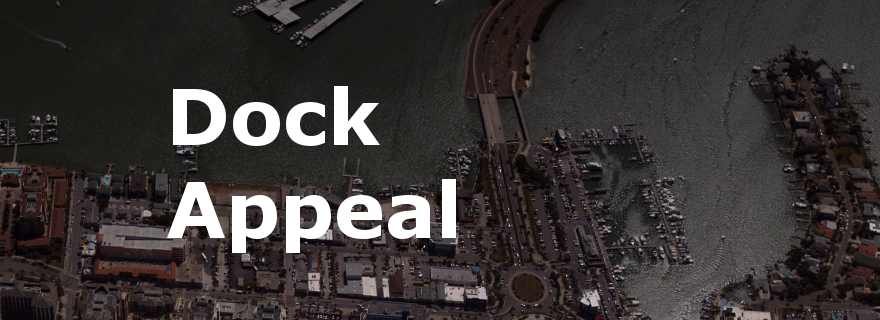By Mary Kelley Hoppe and Victoria Parsons
[su_tabs class=”my-custom-tabs”] [su_tab title=”Clean Marinas”]It’s the waterfront equivalent of the Good Housekeeping Seal of Approval, and an increasing number of marinas are vying for it.
So far, 86 marinas have earned Florida’s Clean Marina designation; another 213 have requested assistance, and dozens of those are completing action plans.
While that’s a drop in the bucket in a state with more than 1800 marinas – more than twice as many as any other state – it’s significant nonetheless.
Marinas and boatyards – and the hundreds of thousands of boats they serve – can significantly impact water quality. Most impacts are cumulative, from countless small fuel spills to incidental oil leaks to heavy detergents used to clean painted hulls laden with copper that flakes off and ends up in bottom sediments.
Enemy one is stormwater runoff, which conveys oils, greases, heavy metals and degreasers from marina and boatyard service areas and parking lots into nearby streams and waterways. Newer facilities are required to treat stormwater, while older facilities, built before current environmental regulations were enacted, are exempt. That’s resulted in a mish-mash of environmental safeguards that run the gamut from none at all to retention ponds that hold and filter contaminants.
Fortunately, many marinas understand that a clean marina is good for business, and the state’s Clean Marina Program is capitalizing on that. “Boaters are looking for dock appeal,” says Jan Delaney of the Florida Department of Environmental Protection, who manages the agency’s Clean Marina/Clean Vessels grants program.
“We’re creating an economic link between a marina’s operations and the environment,” adds Delaney. “We’re formalizing what boaters want.”
Begun in 1999, the voluntary program enlists marinas and boatyards to evaluate their operations, implement a series of environmental housekeeping measures and educate boaters on ways to minimize impacts.
“We couldn’t do this without the partnership of the marine industry,” says Delaney. The Marine Industries Association not only has been instrumental in developing and promoting the program, but they also provide free technical assistance to marinas.
The designation process can take up to 18 months and begins when a facility attends a Clean Marina workshop where they receive a toolkit with videos and information on pollution prevention measures. Participants sign a pledge agreeing to conduct a self-review and complete an action plan within 90 days.
“In the meantime, we make ourselves available for informal walk-throughs,” says Rose Poynor, FDEP’s point person for Clean Marinas on Tampa Bay, to help size up operations and advise owners on ways to improve them. Facilities are awarded points based on a checklist assessing their operations and practices from emergency management and fueling to boat cleaning, stormwater management, sewage pumpout and attention to sensitive habitats. Lease agreements are reviewed to ensure that marinas are encouraging boaters to use sewage pump-out facilities and maintain their boats responsibly.
Education works both ways. Boaters can also exert “pier pressure” on marinas to be better environmental stewards.
A lot of it boils down to good housekeeping, says Poynor. “We recognize that there are costs involved but many of the actions are common-sense practices,” like properly labeling and storing chemicals, cleaning boats with citrus cleaners instead of toxic chemicals, and using liners and drip pans in work areas and under portable gas containers to catch spills.
Good marinas go further, for instance, by stocking the alternative cleaners and environmentally sensitive products they recommend.
Based on a survey of 78 participating marinas, DEP estimates that clean marina recycling efforts alone have kept 5.6 million gallons of oil, 1 million gallons of antifreeze and 3.7 million pounds of aluminum out of the water. Many clean marinas also recycle fishing line and fish carcasses.
The number of sewage pumpout facilities statewide also has increased. Federal clean vessel funds have enabled the state to grant funding for 276 sewage pumpouts since 1995.
For additional information on the Clean Marina Program, including the Clean Marina checklist and best practices, visit: The Florida Department of Environmental Protection.
[/su_tab] [su_tab title=”Tampa Bay Clean Marinas”]Tour Some of Tampa Bay’s Clean Marinas
Tampa Bayside Marina
The buzz is palpable from the minute you arrive. Tampa Bayside Marina is humming – forklifts retrieving boats from dry-dock, throngs streaming in for lunch at the popular Rattlefish Grill, the steady chatter of conversation.
What’s less obvious to the untrained eye are the lengths to which this marina – Tampa’s first dry-dock facility and the first marina in Hillsborough County to earn the Clean Marina designation – has gone to be a good neighbor.
Meticulously maintained, the marina’s dock appeal is more than skin deep. Stormwater drains are outfitted with special pads designed to trap and hold hydrocarbons. A high-tech floorsweeper cleans service bays and drydock areas. “Sheen devils” float alongside fuel docks to pick up stray gas and oil, just one of many signs that Bayside is serious about keeping the marine environment clean.
And forget about fueling your own boat, says marina owner Mike Emmanuel. That’s not allowed. Only Bayside workers can pump fuel. Emmanuel says the extra cost he incurs to staff fuel docks is worth it to reduce the chances of a spill, and customers like the extra service.
On educating boaters, Emmanuel says a lot of it has to do with the environment they’re exposed to. “If there’s trash on the ground, why are you going to pick up yours,” he asks.
Tierra Verde Marina
Jeff Cavanaugh didn’t set out to be one the first dockmasters in the state to earn the Clean Marina designation. It just so happened that he was a board member at Marine Industries Association of Florida when DEP came looking for people who were interested in working on the nascent Clean Marina program.
Now part of Texas-based Sun Resorts International, the Tierra Verde Marina has been so successful that dockmasters at sister marinas in Texas and the Caribbean are looking at implementing similar procedures, he notes. “My bosses have been very supportive of the concept.”
Having worked with FDEP to develop the Clean Marina checklist, few details escape his attention, from white tires on forklifts and drought-resistant landscaping to opportunities for recycling metal parts (an initiative that’s used to pay for the marina’s Christmas party). “It’s a lengthy list but it’s pretty simple,” he says. “You just go down the checklist and add up the points. It doesn’t take a ton of time and the benefits are obvious – it’s good for the environment and it’s one more way to sell your marina.”
Blind Pass Marina
Although they’re still waiting for the official designation, the newest facility in Pinellas to earn a Clean Marina flag is also the only licensed live-aboard marina on St. Pete Beach. “Some people feel like that’s a problem, but we’re doing everything we can to dispute that outlook,” says Todd N ye, dockmaster for Blind Pass Marina. “There’s no reason not to have live-aboards, it’s just a matter of education.”
Use of the marina’s brand-new pump-out system is included in rental charges so there’s no reason not to do the right thing, he adds. Shoreside laundry facilities help eliminate grey water and Nye encourages boaters to use baking soda and hydrogen peroxide for cleaning instead of chlorine bleach. Fishermen are strictly prohibited from throwing carcasses overboard and prominent signs emphasize the damage monofilament line can cause to wildife.
“Most people really want to help keep the environment clean – we just need to educate them on what works and what doesn’t,” he says. “And to be honest with you, the Clean Marina flag isn’t as important as keeping my marina clean. I swim here almost every day and there aren’t a lot of marinas where you would want to do that.”
Largo Intercoastal Marine
Surrounded by mangroves on a landside site in mid-Pinellas County, Largo Intercoastal Marine is on target to earn the first Clean Boatyard flag on Florida’s West Coast later this summer. “We’re getting to the point where if you’re not a Clean Marina, you’ll stand out on a bad list,” says Dock Manager Fred Reyes. “We’d rather be one of the first instead of the last.”
The boatyard designation will emphasize good management practices in Largo Marine’s service department and facilities where vessels are cleaned and painted. Largo Marine, which is part of Santa Rosa Island Company, followed in the footsteps of a sister facility in Jacksonville where the owners were reaping the benefits of participating in the Clean Marina program. “It’s a good investment for us, from a business perspective as well as an environmental perspective,” Reyes said. “We’ve already seen improvements in water clarity, the fishing is better and there is much more wildlife.”
*Note this article was originally published in Summer 2004. For most current Clean Marina Information, please see: http://www.dep.state.fl.us/cleanmarina/
[/su_tab] [su_tab title=”Good Mates”]Even before the FDEP began its Clean Marina program in the early 1990s, environmental managers in Pinellas County had already recognized the potential for public-private partnerships and created the Good Mate program. When Clean Marina was established, Good Mate was wrapped into the statewide initiative.
“The marine industry here has been very involved,” says Gene Quinn, a senior environmental specialist for the Pinellas County Department of Environmental Management. “The biggest challenge we face is developing rapport. When I walk in and say ‘I’m from the government and I want to help,’ their initial reaction is to run.”
Walking in often – usually with brochures, signage and other hand-outs – has made Quinn welcome in most marinas, he said. “We like to have people involved in the Clean Marina program, but we don’t require a certification to help out. We want everyone to pass out pamphlets and put up the signage we provide because we all win when people understand that every boater makes a difference.”
Most marinas in Pinellas, he adds, can check off about 70% of the required activities even before they create the action plan needed to earn a Clean Marina flag. “They already have a good start and we’re here to help them get the rest of the way,” Quinn says.
The next Clean Marina workshop will be held at the Brooker Creek Park educational center on Sept. 23. For more information or to make reservations, contact Quinn at 727-464-4425.
[/su_tab] [/su_tabs]Originally published Summer 2004.
[su_divider]